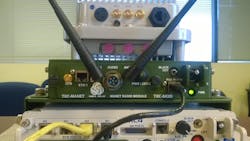Navy ready to approach industry for tactical military cellphones and cloud computing technologies
NORTH CHARLESTON, S.C. – U.S. Navy communications experts plan to approach industry for a prototype low-power secure military cell phone network for warfighters operating on the forward edge of the battlefield.
Officials of the Naval Information Warfare Center (NIWC) Atlantic in North Charleston, S.C., issued a planning document on Tuesday (N65236-19-R-T006) for two initiatives in the Information Warfare Research Project (IWRP). Solicitations for these projects should be released around 25 June 2019.
The first project, called Tactical Microcell (19-LANT-0072), seeks to develop a military ground microcell for forward-deployed warfighters that uses software-defined radios to create communications microcells able to cross-connect dissimilar communication devices like cell phones, laptop computers, and tactical radios.
A microcell is part of a mobile phone network with a low-power cell tower that covers a limited area, and uses power control to limit the radius of its coverage area. Civil uses of microcells include malls, hotels, and transportation hubs.
Navy researchers want a tactical microcell prototype that links by tactical radios back to the military communications infrastructure or to the local cellular system as a tower or a collection of phone instruments.
The second project, called Machine Assisted Rapid-Repository System (19-LANT-0073), will seek a prototype of a commercial-grade military cloud-based service to provide linkage between shore-based data sources of dynamic content and warfighter operating on land, at sea, and in the air.
Two-way data flows are necessary to validate the data or update the data. The project seeks to optimize human-machine interfaces and machine-machine interfaces to create, ingest, validate, or consume live content.
The Navy is letting industry know of their intentions for planning purposes. Officials will release formal solicitations to members of the IWRP Consortium in Summerville, S.C. More information on becoming an IWRP consortium member is online at www.theiwrp.org.
The Naval Information Warfare Systems Command (NAVWAR), formerly was the Space and Naval Warfare Systems Command (SPAWAR). The organization changed its name earlier this month to emphasize its involvement in information and cyber warfare.
For questions or concerns, phone the Navy's Lisa Rosenbaum at 843-218-5982.
More information on the upcoming Tactical Microcell and Machine Assisted Rapid-Repository System projects are online at https://www.fbo.gov/notices/bdea034ce1ce697d2e9e9a7dd048d89c, or at https://e-commerce.sscno.nmci.navy.mil.

John Keller | Editor-in-Chief
John Keller is the Editor-in-Chief, Military & Aerospace Electronics Magazine--provides extensive coverage and analysis of enabling electronics and optoelectronic technologies in military, space and commercial aviation applications. John has been a member of the Military & Aerospace Electronics staff since 1989 and chief editor since 1995.

